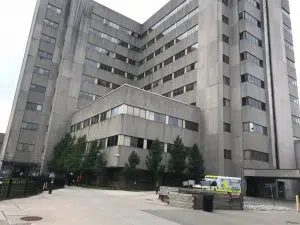London Health Sciences Centre’s University Hospital uncovered a ground-breaking advancement in cardiac surgery. The first robotic assisted aortic valve replacement was conducted by Dr. Bob Kiaii.
Kiaii used the da Vinci surgical system to perform the world-first valve replacement on James Fuller of Straffordville Ontario.
“In the back of your head, you always have some reservations. But I figure robotics is the way things are gonna go. I had faith in Dr. Kiaii so I didn’t have any great concern,” said Fuller.
Dr. Kiaii performed the procedure by using a tissue valve called the Perceval S valve. This new generation valve facilitates performance of less invasive aortic valve replacement.
“The purpose of utilizing this technology is we believe we can do a better operation by technological advancements,” says Kiaii.
Kiaii has become aware of just how beneficial the new technology surgeries are to the patients.
“Because the technology allows you to do a less invasive surgery, the patient recovers quicker. They are able to leave the hospital potentially quicker and also being able to resume back normal activities.”
Less invasive, meaning smaller incisions and precise work that will not damage the surrounding work area of the heart. For James Fuller, the recovery was quick like Dr. Kiaii promised him. The surgery was far less painful and easier than he ever thought.
“Everything’s better now than it was. I used to have trouble bending over with low blood pressure and coming back up. Now that’s gone away. The shortness of breath has gone away. So, I’m back to being thirty-five again.”
Some of Fullers’ friends had the same surgery, but without the new technology he had.
“Some of my friends had the open chest version of this surgery, and my experience has been so different,” says Fuller. “There is no comparison on the level of pain or the time it took me to recover. I was up and going within a few days. When asked my pain scale from one to ten, I was no more than a four.”
For London Health Sciences Centre, the robotic technology has been there for a long time. It has just been about learning and crafting that new technology before putting it to the test on a real procedure.
” We have close to over twenty years of experience with robotic surgery at our institution. We’ve performed almost 1500 robotic cases. so, we’re quite an experienced centre for robotic surgery,” said Kiaii.
It was not until now that the aortic valve replacement has been truly put to the test. James Fuller is grateful that now is the time they decided to try it and he was the first to be the test dummy.
“I don’t even have words for it. I’m just so grateful. I would highly recommend this surgery to anyone.”
Dr. Kiaii has taken another one of these surgeries already into account. One is completed and another is already scheduled in to be performed in another two weeks.
Kiaii says that not every candidate is suitable for the surgery based on the type of the problem they have with their valve, and also based on their chest anatomy.
James Fuller just happened to be the right candidate for surgery and the perfect candidate to create history in London, Ontario.
https://twitter.com/MayavonFrieden/status/1055921031464906752





